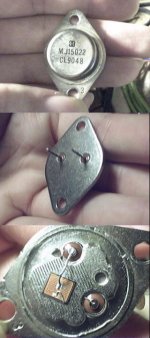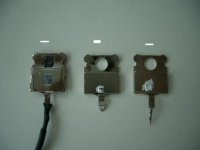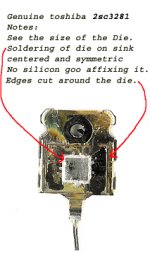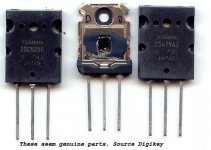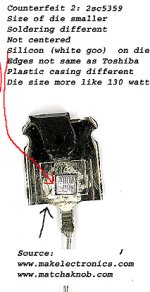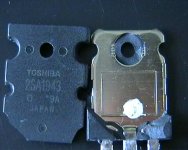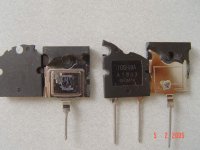This device appears to be from Harris Semicontudtor and date code suggest it was manufactured in 1990. I replaced it in an old amplifier that had more working devices like this
Now I'm in doubt about its authenticity... It has a die small enough to fit into a TO-220 case
Now I'm in doubt about its authenticity... It has a die small enough to fit into a TO-220 case
Attachments
Hi
I break down 3 x SA1943 sourced from three sources.
the 1st one is most difficult one to break as the material is highly coherent / the steel plate is thicker ( whole plate is in same thickness ) / heavier. 2nd one steel plate is same as 3nd one, the lower part is thickner than the upper part, but the wafer ( ?) is smaller.
Which one is real ? Please comment
I break down 3 x SA1943 sourced from three sources.
the 1st one is most difficult one to break as the material is highly coherent / the steel plate is thicker ( whole plate is in same thickness ) / heavier. 2nd one steel plate is same as 3nd one, the lower part is thickner than the upper part, but the wafer ( ?) is smaller.
Which one is real ? Please comment
Attachments
Center and right look like my fakes and the ones on Rod Elliot's site. The dice are about 3mm x 3mm.
In the case of the fakes I got stuck with, I found a simple test to identify them. The fakes have a beta of about 200. Impossible for the real thing (which are somewhere around 40 or 50) and likely an indicator that the chips are intended for small signal devices- probably perfectly good ones - maybe you could use them for current mirrors in an IS stage - duh
In the case of the fakes I got stuck with, I found a simple test to identify them. The fakes have a beta of about 200. Impossible for the real thing (which are somewhere around 40 or 50) and likely an indicator that the chips are intended for small signal devices- probably perfectly good ones - maybe you could use them for current mirrors in an IS stage - duh
Re: More MEV transistors!
MEV brand is from Eastern Europe, but there have been reports of counterfeits of them. Your two parts look different. I would almost say the one on the right is genuine and the one on the left possibly fake. This is based on the marking (MEV marking is thin like the right one), and on the size of the die (although I can't tell for sure, the left one looks small and is hidden by white epoxy, a common dodge). One bad part in the pair could take the amp down. Do you have any new ones to test on a curve tracer? That could be revealing.
The Peasant said:I ...purchased ..MJ15024/MJ15025 transistors with the MEV markings. As soon as any significant power was applied to them they failed, taking out drivers as well.😡
As soon as I started using genuine ON Semi parts the problems ceased.
Here are pics of the MEV parts:
MEV brand is from Eastern Europe, but there have been reports of counterfeits of them. Your two parts look different. I would almost say the one on the right is genuine and the one on the left possibly fake. This is based on the marking (MEV marking is thin like the right one), and on the size of the die (although I can't tell for sure, the left one looks small and is hidden by white epoxy, a common dodge). One bad part in the pair could take the amp down. Do you have any new ones to test on a curve tracer? That could be revealing.
MEV brand is from Eastern Europe, but there have been reports of counterfeits of them. Your two parts look different. I would almost say the one on the right is genuine and the one on the left possibly fake. This is based on the marking (MEV marking is thin like the right one), and on the size of the die (although I can't tell for sure, the left one looks small and is hidden by white epoxy, a common dodge). One bad part in the pair could take the amp down. Do you have any new ones to test on a curve tracer? That could be revealing.
The markings between the two types are certainly a bit different, but inside both types look the same. The one on the left is the way they look when first opened, with white silicone covering the die, while the one on the right has had the white silicone mostly scraped away.
I have lots of new untested parts of both types, but I don't have a curve tracer.
bsyyu said:Hi
I break down 3 x SA1943 sourced from three sources.
the 1st one is most difficult one to break as the material is highly coherent / the steel plate is thicker ( whole plate is in same thickness ) / heavier. 2nd one steel plate is same as 3nd one, the lower part is thickner than the upper part, but the wafer ( ?) is smaller.
Which one is real ? Please comment
The first one looks real. I got the same thing for a 2sc5200 sourced from Digikey (who I trust more than others)
Thats the first picture. I have some other pictures showing a genuine 2sc3281 (taken out from a blown Onkyo M-501).
Weird that the c3281 had a bigger die than the 5200 which is a higher Vce replacement of the c3281. My comments on the dies etc are in the pictures. Email me if you need higher resolution pics.
K-
Attachments
That agrees whith what I saw in my fakes except that in my fake 2sa1943 the dies was even smaller, 3mm x 3mm. The exterior of the fake 2sa1943's I got from Match-a-Knob had a shinny or glossy rectangle on which "2sa1943" was very clearly printed. The real ones, ironicay, are harder to read.
If you have a convenient way to measure hfe, the fakes will read much higher, ~200, than the genuine ones.
Sources: I think digikey is probably safe as they have too much at stake. I also have information from Arrow that they only buy from the manufacturer, Toshiba, so ecen 2sa1302 and 2sc2831 though out of production came directly from Toshiba. I can only speculate, but the really big distributors are probably safe sources.
I don't think Match-a-Knob is intentionally passing off fakes, they just got victimized too. Their 2sc5200's were genuine even though they arrived in the same order as the 2sa1943s. This is a shame since small distributors like these provide a real benefit by buying out excess and surplus inventories and reselling them a very attractive prices. In an honest world this would be a business that benefits everyone.
The suspicion is that these fakes are made somewhere in China. Other Chniese electronics businesses are victims too, because they are trying to get into world markets, but dishonest operations like this cast suspicion on all electronics made there.
If you have a convenient way to measure hfe, the fakes will read much higher, ~200, than the genuine ones.
Sources: I think digikey is probably safe as they have too much at stake. I also have information from Arrow that they only buy from the manufacturer, Toshiba, so ecen 2sa1302 and 2sc2831 though out of production came directly from Toshiba. I can only speculate, but the really big distributors are probably safe sources.
I don't think Match-a-Knob is intentionally passing off fakes, they just got victimized too. Their 2sc5200's were genuine even though they arrived in the same order as the 2sa1943s. This is a shame since small distributors like these provide a real benefit by buying out excess and surplus inventories and reselling them a very attractive prices. In an honest world this would be a business that benefits everyone.
The suspicion is that these fakes are made somewhere in China. Other Chniese electronics businesses are victims too, because they are trying to get into world markets, but dishonest operations like this cast suspicion on all electronics made there.
Agreed, they are probably not doing it intentionally, I contacted MAK and they told me they would refund me all devices I got.
I got 48 pieces from them and 4 were fakes...
I got 48 pieces from them and 4 were fakes...
the sa1943s i removed from my onkyo power amp say toshiba, they are black with very dull finish, and you have to have the right lighting, and tilt side to side just right, to even see the print. they ran about three years in the amp with 8 ohm speakers, with no problems. fake, or real? i don't know! this subject does make a person wonder though! these are still good though. crippledchicken 

If they lasted that long, they're real. You can bet that Onkyo buys in large enough volue that they get them direct ftom Toshiba
Hi all,
I've just been bitten by the fake 2SA1943 semi. I didn't come across ths article until now but I've posted my woes under the 'Phonic 740' thread.
Just to add something, perhaps not particularly useful, but trying to open up the real devices took copius amounts of whacking with a hammer and chisel and it was extremely difficult to open. The fake devices, one tap with the hammer and they split apart very easy. This is not to suggest you use this as a test of course.
I'm going to check the capacitance which was suggested earlier in this thread and see what results I get.
Meanwhile here's a photo of the dodgy device.
Bob 😎
I've just been bitten by the fake 2SA1943 semi. I didn't come across ths article until now but I've posted my woes under the 'Phonic 740' thread.
Just to add something, perhaps not particularly useful, but trying to open up the real devices took copius amounts of whacking with a hammer and chisel and it was extremely difficult to open. The fake devices, one tap with the hammer and they split apart very easy. This is not to suggest you use this as a test of course.
I'm going to check the capacitance which was suggested earlier in this thread and see what results I get.
Meanwhile here's a photo of the dodgy device.
Bob 😎
Attachments
bfisk said:Hi all,
I've just been bitten by the fake 2SA1943 semi. I didn't come across ths article until now but I've posted my woes under the 'Phonic 740' thread.
Just to add something, perhaps not particularly useful, but trying to open up the real devices took copius amounts of whacking with a hammer and chisel and it was extremely difficult to open. The fake devices, one tap with the hammer and they split apart very easy. This is not to suggest you use this as a test of course.
I'm going to check the capacitance which was suggested earlier in this thread and see what results I get.
Meanwhile here's a photo of the dodgy device.
Bob 😎
That clearly a fake. The die is too small and on an original, the top would never come off in one piece.
😀
After mailing the suppliers with the photo they sent me 2 new semis, this time made by Fairchild.
Using the tests suggested earlier in this thread the new devices have an Hfe around 130. The fake Toshiba's were around 160.
A good Toshiba measures around 40.
The capacitance test shows the Fairchild to be about a half that of the good Toshiba and the fake Tosh some 10 times smaller.
The Faichild devices look totally different. I don't have a photo but if anyone is interested I'll take one.
I'm realy unsure now as to whether these new devices are quite up to spec although they do seem a lot better than the Tosh fakes.
Anyone else come across them??
Cheers
Bob 😎
Using the tests suggested earlier in this thread the new devices have an Hfe around 130. The fake Toshiba's were around 160.
A good Toshiba measures around 40.
The capacitance test shows the Fairchild to be about a half that of the good Toshiba and the fake Tosh some 10 times smaller.
The Faichild devices look totally different. I don't have a photo but if anyone is interested I'll take one.
I'm realy unsure now as to whether these new devices are quite up to spec although they do seem a lot better than the Tosh fakes.
Anyone else come across them??
Cheers
Bob 😎
If I want to open up plastic packages. I squeeze them in a vise. This usually makes the epoxy pop right off without a lot of roaring and screaming, and no sweat whatsoever... Logo side facing up, catch the package down at the bottom where the copper tab meets the epoxy and apply pressure.
KS is not uncommon.. They are fairchild transistors.. Same as the 2S series but with the KS..
Looks like Fairchild might be trying to differentiate theirs from others.. Maybe i'm wrong but thats how it appears.
Looks like Fairchild might be trying to differentiate theirs from others.. Maybe i'm wrong but thats how it appears.
bfisk said:After mailing the suppliers with the photo they sent me 2 new semis, this time made by Fairchild.
Using the tests suggested earlier in this thread the new devices have an Hfe around 130. The fake Toshiba's were around 160.
A good Toshiba measures around 40.
The capacitance test shows the Fairchild to be about a half that of the good Toshiba and the fake Tosh some 10 times smaller.
The Faichild devices look totally different. I don't have a photo but if anyone is interested I'll take one.
I'm realy unsure now as to whether these new devices are quite up to spec although they do seem a lot better than the Tosh fakes.
Anyone else come across them??
Cheers
Bob 😎
Bob,
pictures please.
- Status
- Not open for further replies.
- Home
- Amplifiers
- Solid State
- counterfiet sa1943's ??
